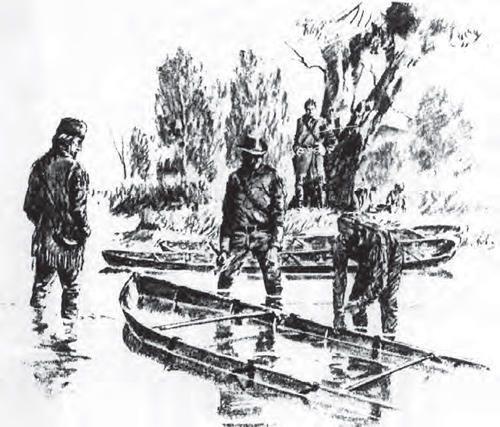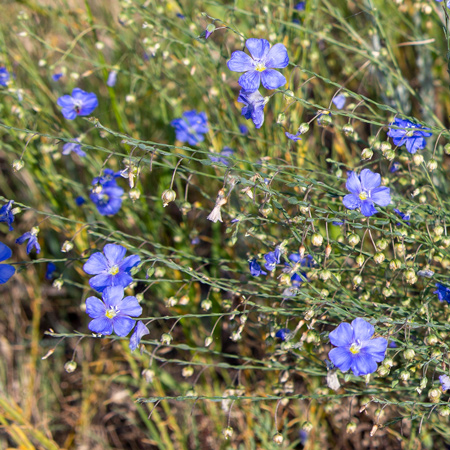The iron-framed boat is finally put into the river where it remains while a storm blows over. They find the boat too leaky, and it is sunk to make disassembly easier. The captains initiate a plan to build two new dugout canoes, and Lewis collects a specimen of blue flax—new to science and a namesake species.
I therefore relinquished all further hope of my favorite boat and ordered her to be sunk in the water, that the skins might become soft in order the better to take her in peices tomorrow and deposite the iron fraim at this place as it could probably be of no further service to us.
—Meriwether Lewis
The Experiment Fails
we corked the canoes and put them in the water and also launched the boat, she lay like a perfect cork on the water. five men would carry her with the greatest ease . . . . we discovered that a greater part of the composition had seperated from the skins and left the seams of the boat exposed to the water and she leaked in such manner that she would not answer.
—Meriwether Lewis
If Only…
had I only singed my Elk skins in stead of shaving them I beleive the composition would have remained and the boat have answered; at least untill we could have reached the pine country . . . . where we might have supplyed ourselves with the necessary pich or gum. but it was now too late to introduce a remidy and I bid a dieu to my boat, and her expected services.—
—Meriwether Lewis
The Boat is Sunk
the time is So far expended that they did not think proper to try any more experiments with it. So we Sank hir in the water So that She might be the easier took to peaces tomorrow.
—John Ordway
Alternate Plan
this falire of our favourate boat was a great disapointment to us, we haveing more baggage than our Canoes would Carry. Concluded to build Canoes for to Carry them; no timber near our Camp. I deturmined to proceed on up the river to a bottom in which our hunters reported was large Trees &c.
—William Clark
Lewis’s Blue Flax
Linum lewisii
Great Falls, Montana. © 29 June 2015 by Kristopher K. Townsend. Permission to use granted under the Creative Commons Attribution-Share Alike 4.0 International license.
Lewis’s Blue Flax Specimen
Perennial Flax. Valleys of the Rocky mountains. July 9th 1806.
—Meriwether Lewis[1]Linum lewisii. Moulton, ed. Herbarium, specimen 92.
Circles of Troughton
Natchez 9th. July 1805
Dear Sir [Thomas Jefferson]
I have considered the methods you propose for ascertaining the Longitude in the event of derangement to the time-keepers. There can be no doubt as to the principle, but it seems to me that the execution will involve some new difficulties. There must be at least two good observers and a nice instrument different from the Sextant: it is at all times a Curious operation to form a meridian sufficiently correct for the purpose of being applied to the ascertainment of the Longitude, and in order to measure the moon’s distance from any meridian, we must have an instrument similar to the Astronomical Circles of Troughton . . . .
William Dunbar[2]Founders Online, National Archives, founders.archives.gov/documents/Jefferson/99-01-02-2049 [originally from The Papers of Thomas Jefferson]; also in Letters of the Lewis and Clark Expedition with … Continue reading
Weather Diary
State of the thermometer at rise
Weather at rise
Wind at rise
State of the Thermometer at 4 P.M. Weather at 4 P.M. Wind at 4 P.M. State of the river 56 [above 0] fair S W. 76 [above 0] cloudy after rain N. W. fallen ¼ in. —Meriwether Lewis[3]To assist the reader, the editor of this web page has omitted the date column, merged the “State of the river” columns, and spelled out some abbreviations.
Experience the Lewis and Clark Trail
The Lewis and Clark Trail Experience—our sister site at lewisandclark.travel—connects the world to people and places on the Lewis and Clark Trail.
Plan a trip related to July 9, 1805:

The Great Falls Portage is a High Potential Historic Site along the Lewis and Clark National Historic Trail managed by the U.S. National Park Service. It includes Sulphur Springs (open to the public) and Lower Portage Camp site (private land), and the Upper Portage Camp Overlook.
Notes
| ↑1 | Linum lewisii. Moulton, ed. Herbarium, specimen 92. |
|---|---|
| ↑2 | Founders Online, National Archives, founders.archives.gov/documents/Jefferson/99-01-02-2049 [originally from The Papers of Thomas Jefferson]; also in Letters of the Lewis and Clark Expedition with Related Documents: 1783–1854, 2nd ed., ed. Donald Jackson (Urbana: University of Illinois Press, 1978), 250. |
| ↑3 | To assist the reader, the editor of this web page has omitted the date column, merged the “State of the river” columns, and spelled out some abbreviations. |




